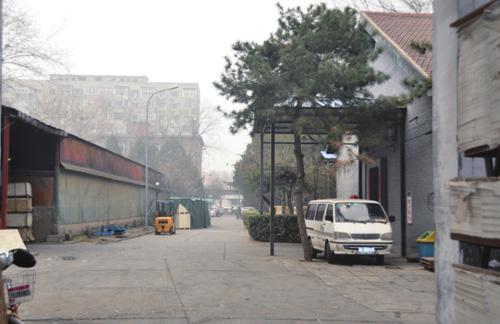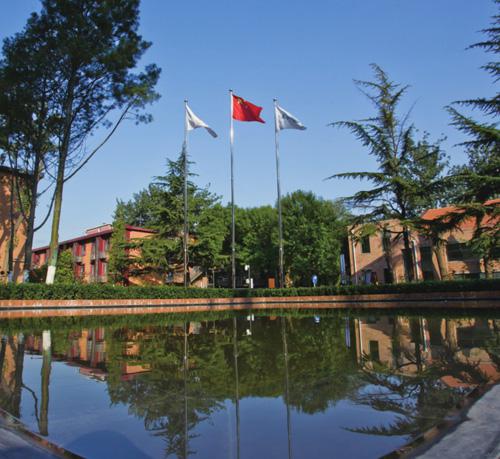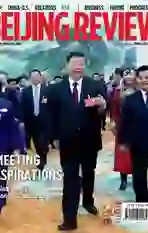Honoring the Old,Building the New
2018-04-08ByLuYan
By Lu Yan


Founded in 1951, the Beijing Foreign Language Printing Factory (BFLPF) was initially a printing company in Chinas capital. With over 1,200 employees, the state-owned company was dedicated for over half a century to printing books, magazines, newspapers and documents in several languages that told the story of the development of China. However, in 2000, the company and its property had a magic makeover. The gray factory buildings were replaced by an innovative campus with modern architecture shining from a clear glass fa?ade. Subsequently, as new enterprises and startups moved in, BFLPFs industrial park was completely transformed into a home for mainly technological and cultural ventures.
According to BFLPF Manager Fan Dongmei, the traditional factory was running at a loss and was on the verge of bankruptcy, but fortunately, the change—which was an inexorable trend—saved it from closing down and propelling unemployment. Some workers became the service staff in the renovated complex, while others chose to end their contracts with the factory.
“The transformation is not yet fi nished. We are now planning to further renovate the property into a national industrial park with the support of the government and business partners,” Fan told Beijing Review.
Renovation and reform
BFLPF is not an isolated case. In recent years, many traditional factory areas in Beijing have taken on a whole new look as more policies are carried out to reform the capitals functions and orientation.
At the end of 2017, the Beijing Municipal Government Office released guidelines on protecting old plants by remaking them into cultural spaces. It stated that these plants carry the history of Beijings industrial development and are valuable public resources that should be revived as cultural facilities for the improvement of the citys dynamic image and competitive edge.
For example, Beijing Gear Works (BGW) in Chaoyang District and beyond is a familiar name for many long-time residents in the area. The factory, established in 1960, witnessed the growth of Chinas automobile parts manufacturing industry. In 1991, it reached its peak when it secured first place in the industry with 4,300 employees and 225 million yuan ($35.54 million) in revenue, contributing 41 million yuan($6.48 million) in taxes to the country.
However, just like BFLPF, its former achievements could not guarantee its safety forever. With the fast development of the city and the countrys economy, BGW could hardly make ends meet.
But in 2013, after a recapitalization and bankruptcy reorganization, BGW began moving its plant to Huanghua in neighboring Hebei Province. It then rebuilt the old block into an industrial park housing more than 36,000 cultural and creative companies as well as auxiliary facilities such as a suspended running track, a gym, a café, a bookstore, an art gallery and a movie theater, offering exercise, relaxation and entertainment to its new tenants.
According to Feng Chunqiu, head of the National Cultural Industry Innovation Experiment Zone of Chaoyang District, the area aspires to make full use of the fastgrowing cultural industry and to explore new development patterns for the city.
“By streamlining property use, we are trying to make the district attractive to high value-added businesses and innovative enterprises,” he said.
As the previous base for Beijings textile, electronic, mechanical, chemical engineer- ing and automobile industries, Chaoyang District has the largest number of old plants in the city. By the end of September 2017, 41 plants had completed their renovations, spanning 2.11 million square meters, according to the China Land and Resources News.
Currently there are over 200 old plant blocks in Beijings 16 districts. Besides Chaoyang, other areas are also doing their part in remolding the capital into a city of innovation. For example, Xicheng District completed half of its 12 projects by the end of September 2017; two of Haidian Districts blocks—the 7 68 Creative Industry Park and the DTV Science Park—generated an output value of 5 billion yuan ($789 million) in 2016; Fengtai District rebuilt 190,000 square meters and attracted 623 cultural and innovation enterprises.
“We will learn from similar experiences at home and abroad and combine protective utilization with innovative renewal,” said Du Feijin, head of the Beijing Municipal Committee Publicity Department.
Expanding the blueprint
Beijings city management and construction has been one of the Central Governments major focuses. In February 2014, President Xi Jinping said during his inspection tour of Beijing that the capital should be made into the countys center of politics, cultural development, international exchange and scientifi c and technological innovation.
Renovating old factories is just a drop in the bucket. The Beijing municipal government report for 2018 unveiled plans to build four key centers for scientif ci, technological and economic development in the city. In the f irst half of 2018, the municipal government will complete its plans for building the centers.
While enjoying rapid expansion, Beijing—with more than 21.7 million people—is plagued with common urban ills such as excessive population, air pollution, heavy traffi c and persistent high housing prices.
As a result, phasing out non-capital functions, including manufacturing, logistics, wholesale markets and some public services has become a key phase in the further plan- ning of the city. According to a government guideline on Beijing-Tianjin-Hebei coordinated development approved in 2015, noncapital functions amass a huge amount of people inside Beijing.
“The medium-term target of the strategy is to control the permanent population of Beijing to within 23 million by 2020 and to relieve Beijing of its urban ills,” said the guideline.
According to the document, Beijings neighboring Tianjin municipality and Hebei Province will share some of the capitals functions. Tianjin will further develop as a national research and development base for advanced manufacturing industry; a shipping hub for north China; a pilot area for fi nancial innovation; and an experimental area for further reform and opening up. Hebei will continue to become an important national base for trade and logistics; a pilot area for modern urbanization and coordinated development of urban and rural areas; and an ecological buffer zone.
Progress can already be noted. The average annual density of PM2.5 particles in the air in the Beijing-Tianjin-Hebei area dropped by 39.6 percent in 2017 compared with the average level in 2013, while 594 wholesale markets were reorganized or removed from Beijing.
“We will continue to establish a modern economic system that is in line with the capitals strategic positioning in order to make Beijing an international fi rst-class city that is more harmonious and habitable,” said Cai Qi, Secretary of the Beijing Municipal Committee of the Communist Party of China, in an interview with Xinhua News Agency.
